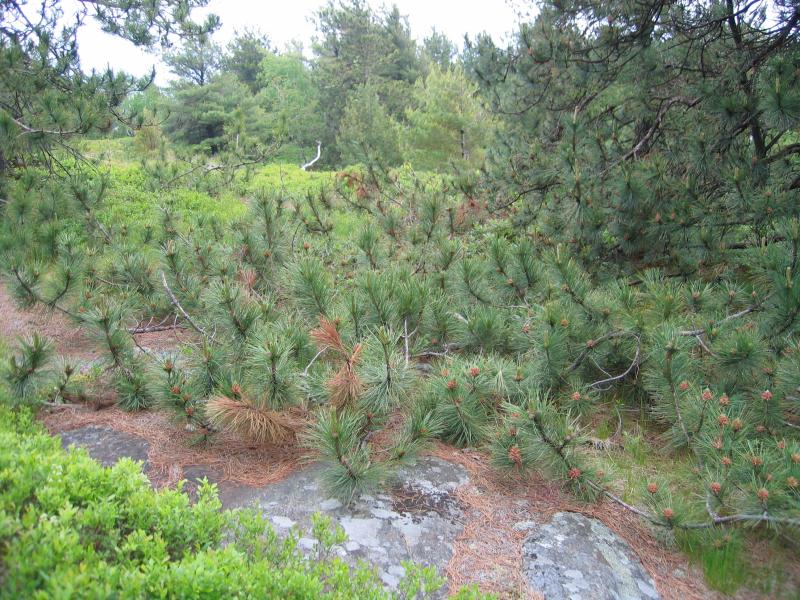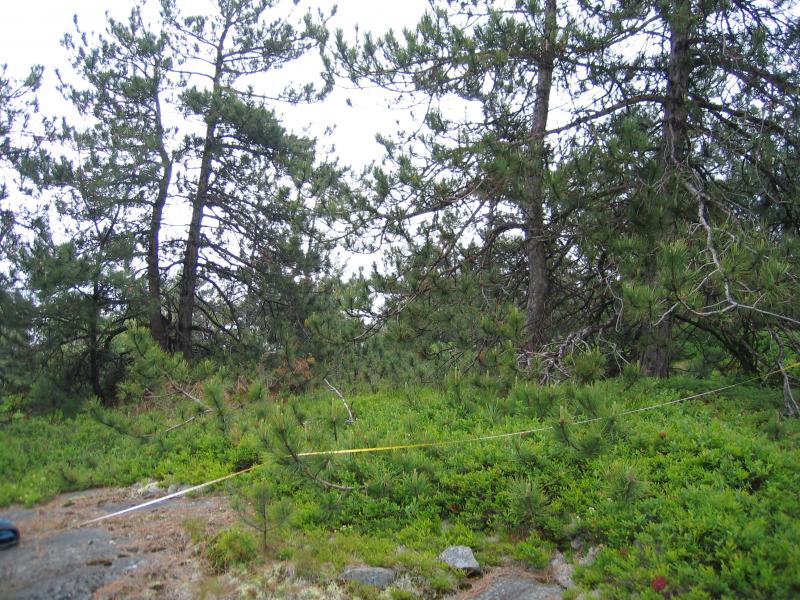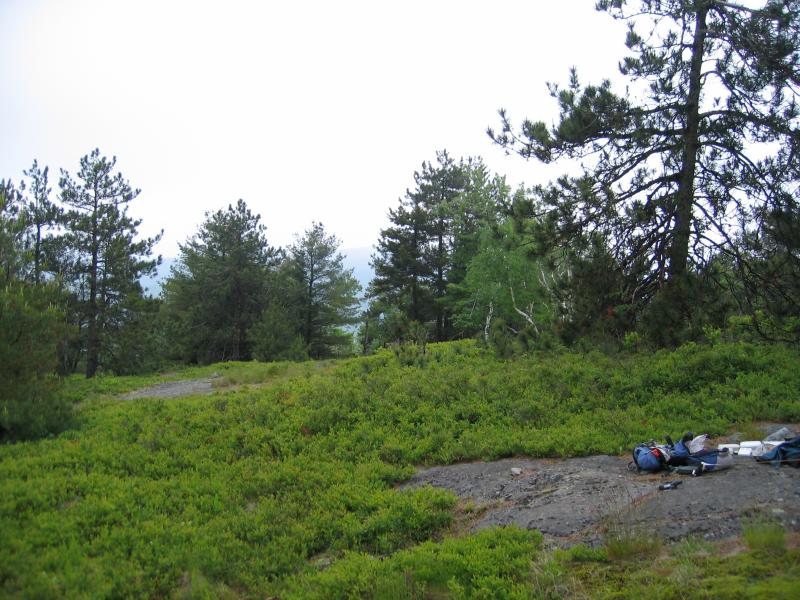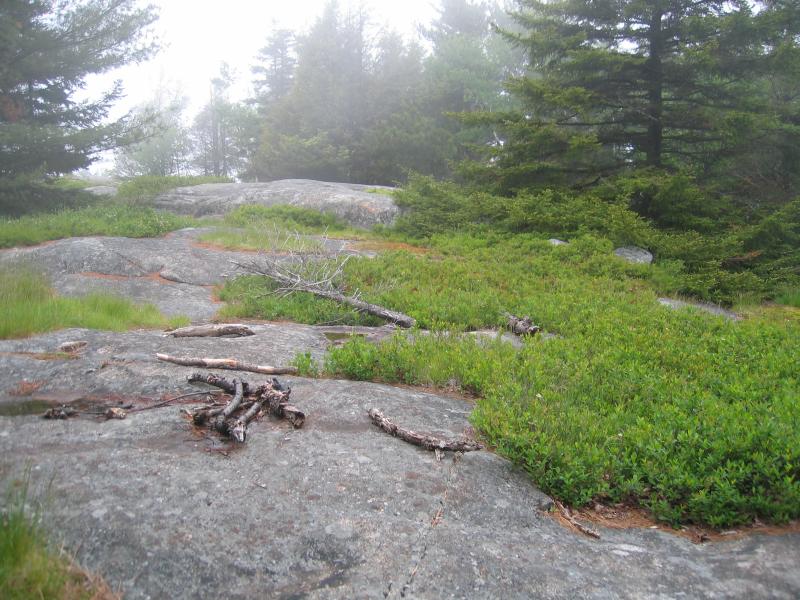Red Pine Rocky Summit
- System
- Terrestrial
- Subsystem
- Barrens And Woodlands
- State Protection
- Not Listed
Not listed or protected by New York State.
- Federal Protection
- Not Listed
- State Conservation Status Rank
- S3
Vulnerable in New York - Vulnerable to disappearing from New York due to rarity or other factors (but not currently imperiled); typically 21 to 80 populations or locations in New York, few individuals, restricted range, few remaining acres (or miles of stream), and/or recent and widespread declines.
- Global Conservation Status Rank
- G4
Apparently Secure globally - Uncommon in the world but not rare; usually widespread, but may be rare in some parts of its range; possibly some cause for long-term concern due to declines or other factors.
Summary
Did you know?
Red pine (Pinus resinosa) has long, thick needles in bundles of two that are dark green and snap cleanly when bent. White pine (Pinus strobus) has soft, slender needles in bundles of five that are pale green in color. Pitch pine (Pinus rigida) has stiff, thick needles in bundles of three that are dark green in color.
State Ranking Justification
Given the limited distribution of red pine in New York, this community was likely never common in the state. There are probably fewer than 20 occurrences left in good condition, and the sizes are presumed to be relatively small. One documented occurrence has good viability and is protected on public land. This community has a somewhat limited statewide distribution (correlated to slightly acidic to low pH bedrock geology). Most examples are presumed to be relatively small and disturbed. This community has probably declined from historical numbers that were likely low and the currently documented occurrence has only minor threats including fire suppression and recreational overuse.
Short-term Trends
The number and acreage of red pine rocky summits in New York have probably declined slightly in recent decades as a result of fire suppression and recreational disturbances.
Long-term Trends
The number and acreage of red pine rocky summits in New York have probably declined moderately from historical numbers as a result of fire suppression, summit clearing for development, and mining of mineral resources.
Conservation and Management
Threats
Red pine rocky summits are threatened by development (especially plans for cellular telephone and radio towers, wind farms, etc.) and trampling by recreational visitors (e.g., mountain bikers and hikers). Given the stunted and gnarly growth form of summit trees, the community is only minimally threatened for timber resources. Summits on unprotected land may targeted for mining of mineral resources. Clearing in the adjacent forest may be a threat that provides corridors for invasive plants. Natural fire regimes (e.g., from lightning strikes) may be suppressed in some areas, but are apparently intact at many sites, especially in the Adirondacks. Southern pine beetle (Dendroctonus frontalis) is a bark beetle that infests pine trees, such as pitch pine, white pine, and red pine. Southern pine beetle is native to the southeastern United States, but its range has spread up the east coast to Long Island, New York in 2014. Natural communities dominated or co-dominated by pines would likely be most impacted by southern pine beetle invasion.
Conservation Strategies and Management Practices
Management activities should include the development and implementation of prescribed burn plans at appropriate sites. Fragmenting features such as roads, abandoned tower clearings, and unnecessary trails should be reduced or minimized, and high-impact recreational activities should be restricted to trails and least sensitive areas. Prevent the dumping of trash and off-trail trampling at heavily visited summits.
Development and Mitigation Considerations
Soils are very thin within and around this community, and the effect of clearing and construction on soil retention and erosion must be considered prior to any development activities. Similarly, these soils are nutrient-poor, and any soil enrichment contamination (e.g., from septic leach fields or fertilized lawns) of this community can alter community structure and function. The open structure of this community is maintained by fire and presents a fire hazard to existing and proposed development. Unprotected structures located within or near this community are more susceptible to damage from fire.
Inventory Needs
Survey leads for purported native, naturally occurring red pine stands on mountain summits and slopes in New York, especially in the Adirondacks. A statewide review of red pine rocky summits is desirable. Continue searching for large sites in good condition (A- to AB-ranked).
Research Needs
Research is needed to determine the role of fire in maintaining this community. Research the susceptibilty of this community to southern pine beetle infestation.
Rare Species
Range
New York State Distribution
This community is limited to the fire prone summits of mid-elevation mountains, or mid-slope outcrops of higher elevation mountains, primarilay in the Adirondacks and possibly in the Catskills.
Global Distribution
Red pine rocky summits are scattered across the glaciated regions of the northeastern United States (and possibly adjacent Canada).
Best Places to See
- Buck Mountain (Washington County)
Identification Comments
General Description
Red pine rocky summits occur on cool, dry, rocky ridgetops and summits where the bedrock is non-calcareous, and the soils are more or less acidic. Red pine is typically dominant, but may also be codominant with red oak and/or white pine.
Characters Most Useful for Identification
Red pine rocky summits occur on cool, dry, rocky ridgetops and summits where the bedrock is non-calcareous (such as anorthosite, quartzite, or sandstone), and the soils are more or less acidic. Red pine (Pinus resinosa) is typically dominant, but may also be codominant with red oak (Quercus rubra) and/or white pine (Pinus strobus). Other trees include red maple (Acer rubrum), paper birch (Betula papyrifera), serviceberry (Amelanchier arborea), and red spruce (Picea rubens). Characteristic shrubs include lowbush blueberries (Vaccinium angustifolium, V. pallidum) chokeberry (Aronia melanocarpa), common juniper (Juniperus communis), and bearberry (Arctostaphylos uva-ursi). Characteristic herbs include tufted hairgrass (Avenella flexuosa), poverty-grass (Danthonia spicata), bracken fern (Pteridium aquilinum var. latiusculum), three-toothed cinquefoil (Sibbaldiopsis tridentata), Pennsylvania sedge (Carex pensylvanica), Canada mayflower (Maianthemum canadense), trailing arbutus (Epigaea repens), and wintergreen (Gaultheria procumbens). Rock outcrops are dominated by various crustose, foliose, and fruticose lichens. Characteristic mosses include haircap moss (Polytrichum juniperinum) and Hedwigia ciliata.
Elevation Range
Known examples of this community have been found at elevations between 1,720 feet and 2,876 feet.
Best Time to See
Spectacular views of Lake George can be seen year round from the red pine rocky summit atop Buck Mountain in Washington County.
Red Pine Rocky Summit Images
Classification
International Vegetation Classification Associations
This New York natural community encompasses all or part of the concept of the following International Vegetation Classification (IVC) natural community associations. These are often described at finer resolution than New York's natural communities. The IVC is developed and maintained by NatureServe.
- Red Pine / Black Huckleberry - Lowbush Blueberry Woodland (CEGL006010)
NatureServe Ecological Systems
This New York natural community falls into the following ecological system(s). Ecological systems are often described at a coarser resolution than New York's natural communities and tend to represent clusters of associations found in similar environments. The ecological systems project is developed and maintained by NatureServe.
- Northern Appalachian-Acadian Rocky Heath Outcrop (CES201.571)
Characteristic Species
-
Trees > 5m
- Acer pensylvanicum (striped maple)
- Acer rubrum var. rubrum (common red maple)
- Amelanchier arborea (downy shadbush)
- Betula papyrifera (paper birch)
- Fraxinus americana (white ash)
- Picea rubens (red spruce)
- Pinus resinosa (red pine)
- Pinus strobus (white pine)
- Quercus rubra (northern red oak)
- Tsuga canadensis (eastern hemlock)
-
Shrubs 2 - 5m
- Acer pensylvanicum (striped maple)
- Amelanchier arborea (downy shadbush)
- Betula papyrifera (paper birch)
- Betula populifolia (gray birch)
- Picea rubens (red spruce)
- Pinus resinosa (red pine)
- Pinus strobus (white pine)
- Tsuga canadensis (eastern hemlock)
-
Shrubs < 2m
- Acer pensylvanicum (striped maple)
- Aronia melanocarpa (black chokeberry)
- Betula papyrifera (paper birch)
- Comptonia peregrina (sweet-fern)
- Juniperus communis var. depressa (American common juniper, ground juniper)
- Picea rubens (red spruce)
- Pinus resinosa (red pine)
- Spiraea alba var. latifolia (broad-leaved meadow-sweet)
- Vaccinium angustifolium (common lowbush blueberry)
- Vaccinium pallidum (hillside blueberry)
-
Herbs
- Avenella flexuosa (common hair grass)
- Carex pensylvanica (Pennsylvania sedge)
- Danthonia spicata (poverty grass)
- Maianthemum canadense (Canada mayflower)
- Pteridium aquilinum ssp. latiusculum (eastern bracken fern)
- Sibbaldia tridentata (three-toothed cinquefoil)
-
Nonvascular plants
- Cladonia sp.
- Hedwigia ciliata
- Polytrichum juniperinum
Similar Ecological Communities
- Pine-northern hardwood forest
(guide)
While both communities have red pine as an important component, pine-northern hardwood forest have 60% or greater tree canopy cover (>5 m) and red pine rocky summits have tree cover 25-60% with numerous rock outcrops. Trees are often stunted and contorted in summit communities. Red pine rocky summits can grade downslope into pine-northern hardwood forest.
- Pitch pine-oak-heath rocky summit
(guide)
While both communities occur on non-calcareous bedrock and have a heath component, pitch pine-oak-heath rocky summits have pitch pine, various tree oak species, and scrub oak compared to red pine rocky summits that are dominated by red pine with lesser amounts of white pine and red oak. Scrub oak and pitch pine are not characteristic of red pine rocky summits.
- Spruce-fir rocky summit
(guide)
While both communities occur on non-calcareous bedrock and have a heath component, spruce-fir rocky summit are dominated by red spruce and balsam fir, whereas red pine rocky summits are dominated by red pine with lesser amounts of white pine, red oak, and red spruce.
Vegetation
Percent cover
This figure helps visualize the structure and "look" or "feel" of a typical Red Pine Rocky Summit. Each bar represents the amount of "coverage" for all the species growing at that height. Because layers overlap (shrubs may grow under trees, for example), the shaded regions can add up to more than 100%.
Additional Resources
References
Cook, D.B., R.H. Smith, and E.L. Stone. 1952. The natural distribution of red pine in New York. Ecology 33 (4): 500–512.
Edinger, G. J., D. J. Evans, S. Gebauer, T. G. Howard, D. M. Hunt, and A. M. Olivero (editors). 2014. Ecological Communities of New York State. Second Edition. A revised and expanded edition of Carol Reschke’s Ecological Communities of New York State. New York Natural Heritage Program, New York State Department of Environmental Conservation, Albany, NY. https://www.nynhp.org/ecological-communities/
Edinger, Gregory J., D.J. Evans, Shane Gebauer, Timothy G. Howard, David M. Hunt, and Adele M. Olivero (editors). 2002. Ecological Communities of New York State. Second Edition. A revised and expanded edition of Carol Reschke's Ecological Communities of New York State. (Draft for review). New York Natural Heritage Program, New York State Department of Environmental Conservation. Albany, NY. 136 pp.
New York Natural Heritage Program. 2024. New York Natural Heritage Program Databases. Albany, NY.
Links
About This Guide
This guide was authored by: Gregory J. Edinger
Information for this guide was last updated on: May 16, 2024
Please cite this page as:
New York Natural Heritage Program. 2024.
Online Conservation Guide for
Red pine rocky summit.
Available from: https://guides.nynhp.org/red-pine-rocky-summit/.
Accessed July 27, 2024.





